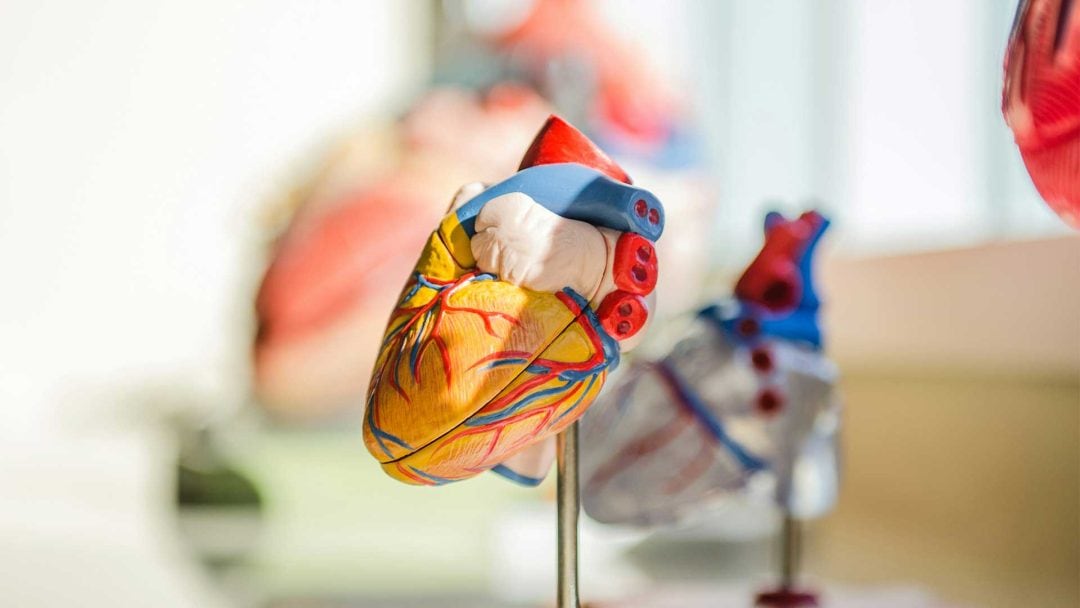Coronary Artery Disease

Coronary Artery Disease (CAD) is a common chronic disease of the heart that is caused by blockages of the blood vessels of the heart (coronary arteries). Coronary artery disease can also be referred to as Coronary Heart Disease (CHD), ischemic heart disease (IHD), arterial occlusive disease (AVD) of the heart, myocardial ischemia, or simply heart disease. As the disease progresses, there is an increased reduction in blood flow to the heart, which can lead to heart failure in the long term and a heart attack.
Constricted Coronary Arteries due to Coronary Sclerosis
Coronary artery disease occurs when fat, cholesterol, calcium and other substances build up as plaque in the arteries. This plaque build up process is called atherosclerosis.
When the plaque build up occurs in the blood vessels that supply oxygen-rich blood to your heart (coronary arteries), it is also known as coronary sclerosis. As the name suggests, it leads to progressive sclerosis (hardening or stiffness of the tissue) or calcification (a buildup of calcium) of the coronary arteries.
At the beginning of calcification, the space of the blood vessels is still large enough so that no symptoms occur. Over time, the narrowed coronary arteries cannot transport enough blood to the organs and tissues in time. As a result, the blood supply is no longer sufficient for the whole body and corresponding symptoms become noticeable. This condition, which can no longer be compensated for, is then referred to as coronary artery disease.
Angina Pectoris
Angina pectoris is a main symptom of coronary artery disease. Angina pectoris means in Latin “the choking of the chest”. The reduced supply to the heart muscle leads to the typical angina pectoris symptoms of pain, tightness and pressure in the chest area. The pain can radiate to the shoulder, back and head and is often accompanied by a feeling of suffocation, sweating and anxiety.
Angina pectoris is often triggered by physical exertion that exceeds the constricted level of blood supply to the coronary arteries. However, stress and cold can also trigger angina pectoris.
Angina pectoris over a longer period of time can lead to a heart attack and should therefore be diagnosed as soon as possible and treated immediately. For immediate relief, a nitro spray is used. Then the coronary vessels are quickly dilated, the blood flow increases again and the chest pain subsides.
Causes of Coronary Artery Disease
There are many different causes to CAD, which are closely linked and can build up on each other. Next to coronary sclerosis or arteriosclerosis, main triggers are smoking and high blood pressure. However, diabetes, obesity and certain medications are also risk factors.
From a holistic perspective, these risk factors are also at cause:
- Toxic exposure, for example the mercury from amalgam or other sources
- Intestinal dysbiosis and intestinal diseases such as leaky gut
- Hidden inflammations (silent inflammation), such as periodontitis or jaw inflammations
- Hidden infectious diseases
- Metabolic disorders
- Deficiencies in vitamins, minerals and trace elements
- Unhealthy diet
Treatment of Coronary Artery Disease
To treat coronary artery disease successfully, all risk factors should be reduced. Therefore, lifestyle changes, a healthy diet, regular exercise and giving up smoking are important foundations for effective treatment.
Risk factors such as diabetes mellitus, hypercholesterolaemia and high blood pressure should be treated by a doctor. In advanced cases of CAD, interventional procedures such as angioplasty (for example using a balloon) or bypass operations may be necessary. However, these are only symptom treatments and do not take away the causes.
From a holistic medicine perspective, the following measures could be applied:
- Infusion therapy, for example with Chelation therapy
- Detoxifying the body
- Intestinal rehabilitation
- Amalgam removal under protection
- Removal of jaw inflammation, such as FDOK / NICO, after precise diagnostics using DVT 3D and CaviTAU
- Compensation of micronutrient deficiencies
- Treat possible hidden metabolic disorders, such as HPU
- Cleaning the blood to reduce the amount of cholesterol, for example with the help of INUSpheresis
Med. pract. Dana Hreus M.A.
When treating coronary artery disease, it is essential to treat all the causes, as otherwise the disease may progress gradually. Moreover, an integrative approach with experienced specialists from different disciplines is important for successful and effective treatment.

Further information
The information listed contains relevant topics and serves to improve understanding.